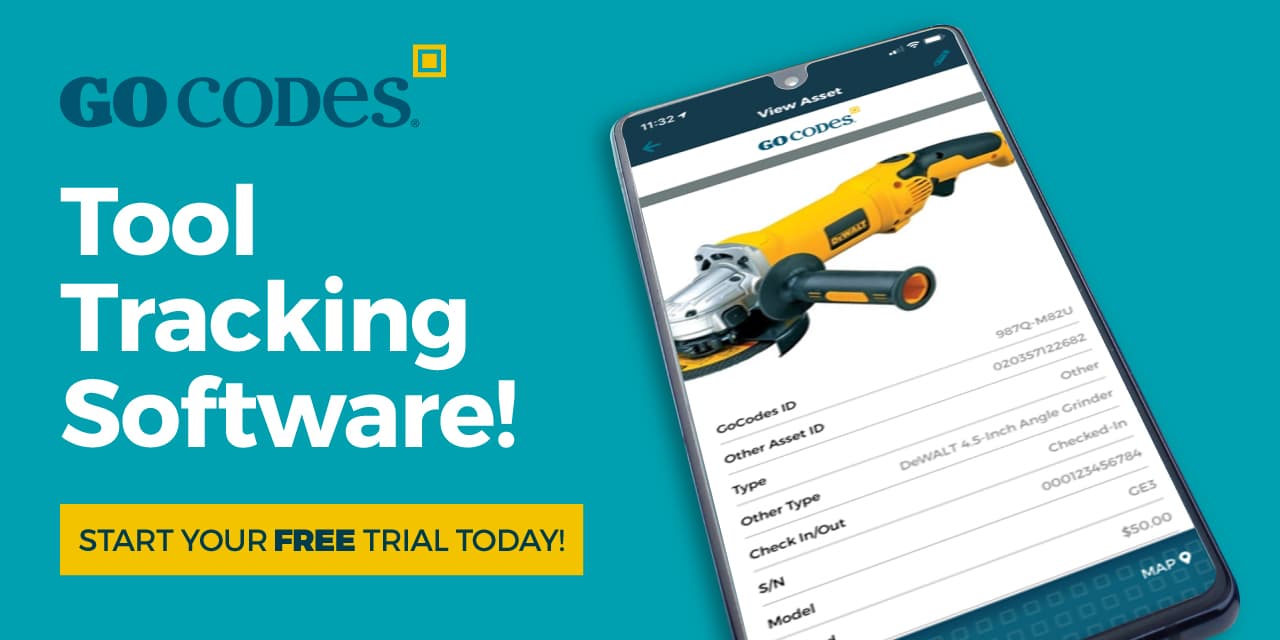Struggling to keep track of tools scattered across multiple jobsites?
That’s what happens when you’re navigating messy and outdated spreadsheet records.
QR code-based tracking systems simplify tool management with fast check-in/check-out capabilities, detailed usage histories, and timely maintenance alerts.
Today, we’ll walk you through six standout solutions built to simplify tool tracking and boost accountability on-site.
In this article...
GoCodes Asset Tracking
GoCodes Asset Tracking is a QR code-based tool tracking and asset management system for construction, field service, and equipment rental companies.
Perfect for small to mid-sized teams that need a fast, affordable, and mobile-first platform, the system is built around rugged, customizable QR code labels that attach securely to tools of any size.
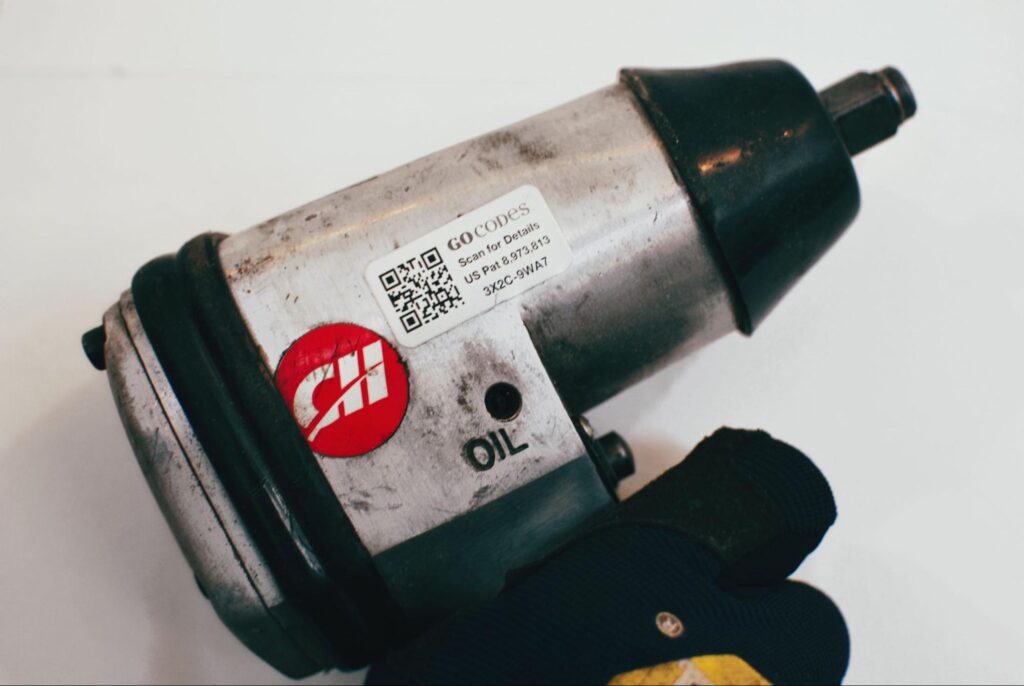
Source: GoCodes Asset Tracking
Unlike most other solutions on the list, there are dozens of options when it comes to label size, material type, and tamper-evident options.
One thing’s for sure: QR-code metal tags are tough enough to withstand harsh jobsite conditions.
Once scanned using the mobile app, each tool’s check-in/check-out status, usage history, and assigned worker are instantly updated and can be accessed from the central database.
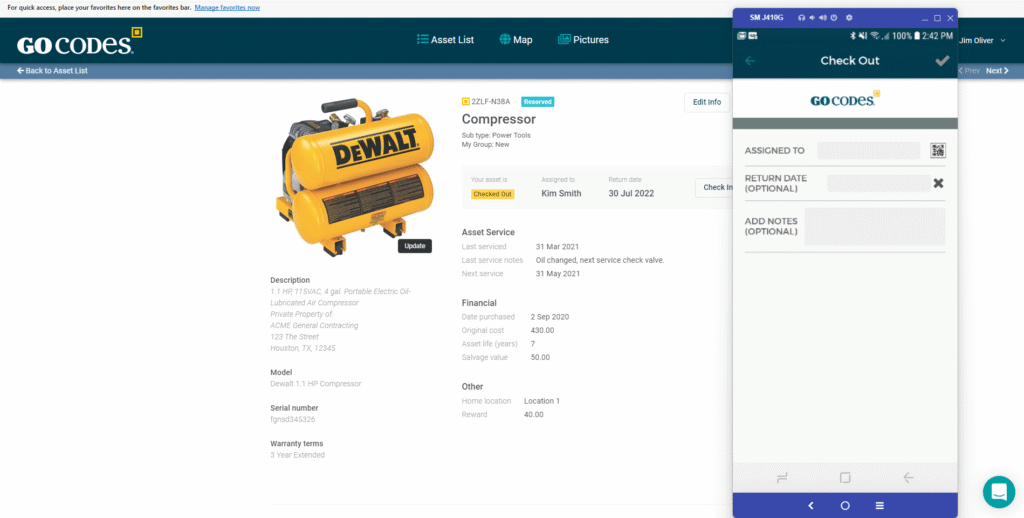
Source: GoCodes Asset Tracking
GoCodes Asset Tracking’ intuitive dashboard enables you to add serial numbers, warranty details, or inspection dates, as well as make use of multiple custom fields.
The system supports essential features like maintenance scheduling and enterprise reporting.
GoCodes Asset Tracking’ reports can telling you all you need to know about your assets, from utilization data to depreciation rates.
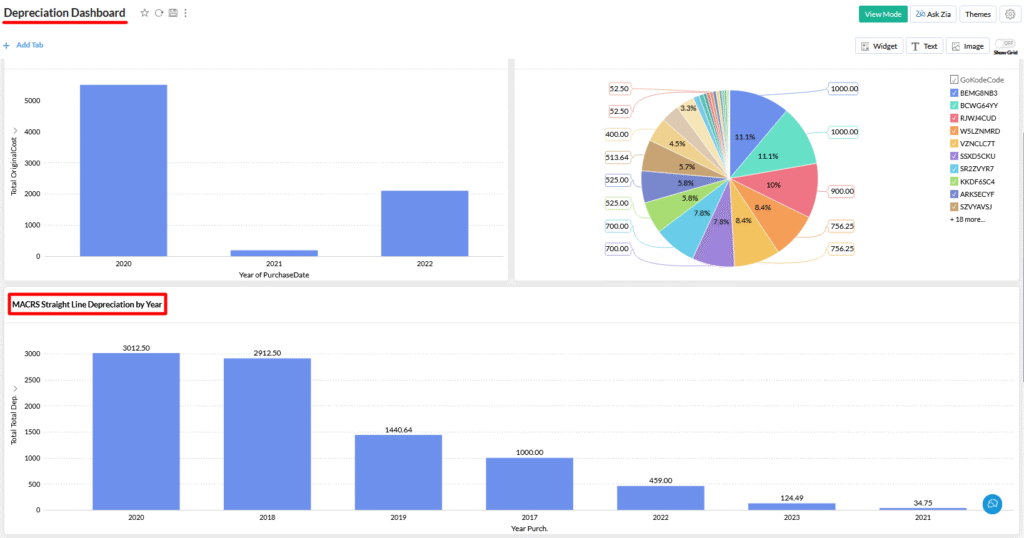
Source: GoCodes Asset Tracking
GoCodes Asset Tracking’ chief advantage is straightforward QR code tagging that can be easily complemented with real-time GPS trackers.
GPS asset tracking is ideal for high-value assets and tool or material shipments, giving managers greater visibility and control over key resources.

Source: GoCodes Asset Tracking
GoCodes Asset Tracking is ideal for companies that need reliable tool management without complexity, and this is confirmed by users who consistently praise the system’s ease of use and adaptability to different needs.
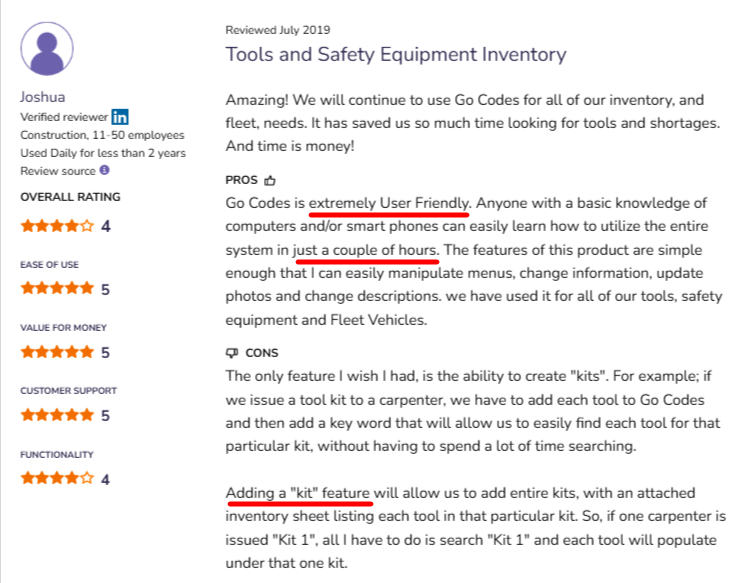
Source: Software Advice
The tool kitting feature mentioned in the review has since been added to the standard offering, as well as optional modules—another reflection of GoCodes Asset Tracking’ ongoing responsiveness to customer needs.
On top of that, GoCodes Asset Tracking prioritizes affordable and transparent pricing, with the Standard plan starting at $500 annually.

Source: GoCodes Asset Tracking
GoCodes Asset Tracking is a dependable, plug-and-play choice for construction crews that need solid QR code tool tracking with mobile convenience and none of the fuss.
ToolSense
Next on the list is ToolSense, an AI-driven asset management platform designed for businesses across multiple industries, including construction.
The system features built-in QR code generation and bulk printing tools, but unlike other solutions on this list, it doesn’t supply rugged, jobsite-grade tags directly.
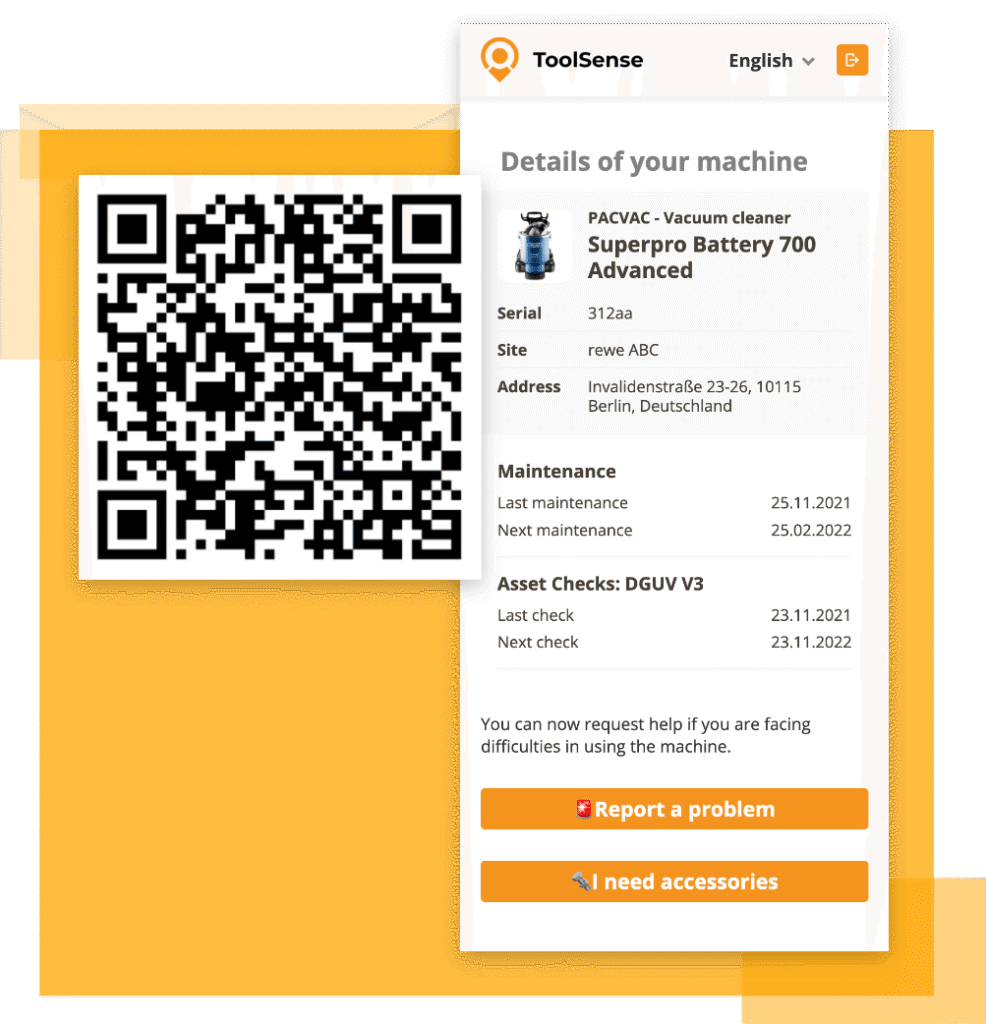
Source: ToolSense
This means you’ll need to print labels yourself using durable materials from an external supplier to ensure they hold up in tough field conditions.
While many asset tracking tools focus on centralized databases or basic activity tracking, ToolSense goes a step further with real-time insights and IoT integration for maintenance management.
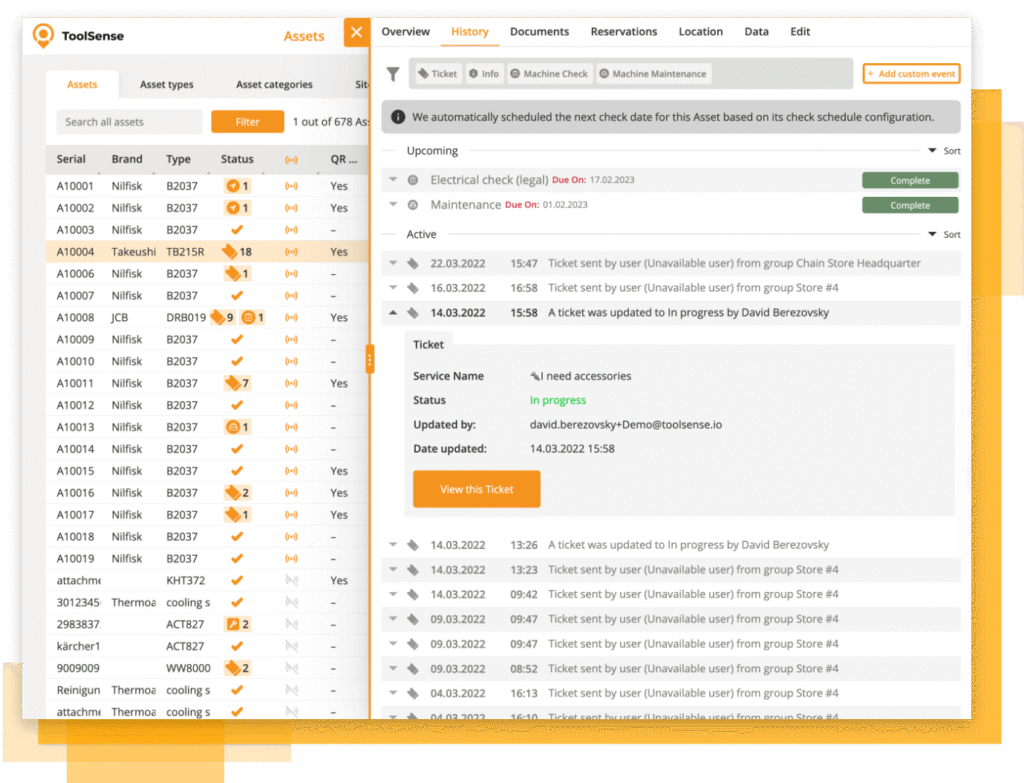
Source: ToolSense
Its intuitive dashboard keeps you up to date on each asset’s past, present, and future usage, helping extend asset life and optimize costs.
That said, some users mention occasional data overload and a learning curve as drawbacks.
The platform is very versatile and suitable for mixed-asset environments. In addition to tool tracking via QR codes, it supports BLE sensors for real-time vehicle tracking, as shown below.
Source: ToolSense on YouTube
Another standout is the AI assistant, which delivers valuable insights on tool usage patterns, cost management, and more, all the while automating scheduling and similar tasks.
While access to real-time data and other features geared toward operational efficiency is a huge plus for users, there are still comments on limited customization.

Source: Capterra
Moreover, ToolSense requires an upfront investment in both hardware and software, which makes it less attractive to smaller businesses or teams with simpler tracking needs.
You can preview the available modules online, but you’ll still need to reach out to the ToolSense team for a custom quote based on the selected features.
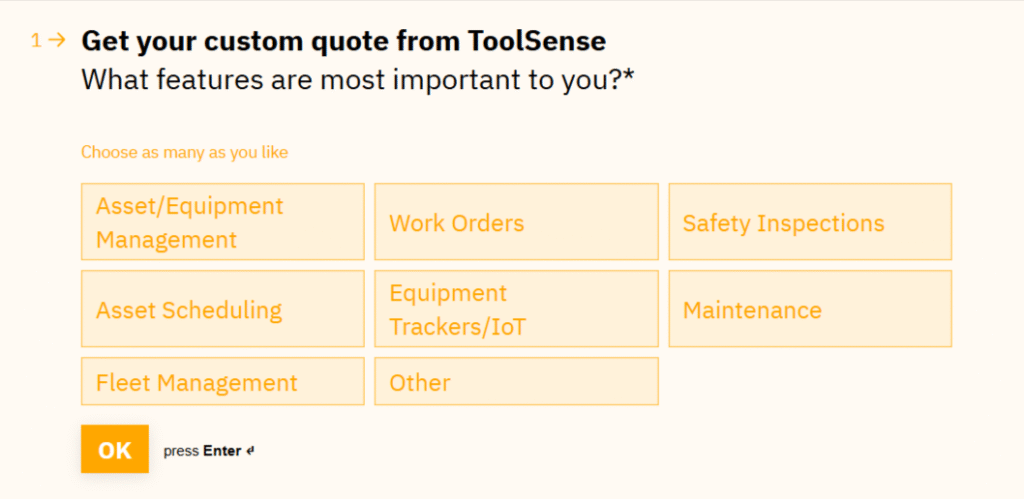
Source: ToolSense
In any case, QR code-based inventory and asset tracking are a standard in every plan, while maintenance scheduling and work order management are exclusive to the Enterprise tier.
ShareMyToolbox
ShareMyToolbox is a small tool tracking software that offers a user-friendly interface optimized for mobile devices.
Their cloud-based app uses barcodes or QR codes to enable a straightforward asset tracking system.
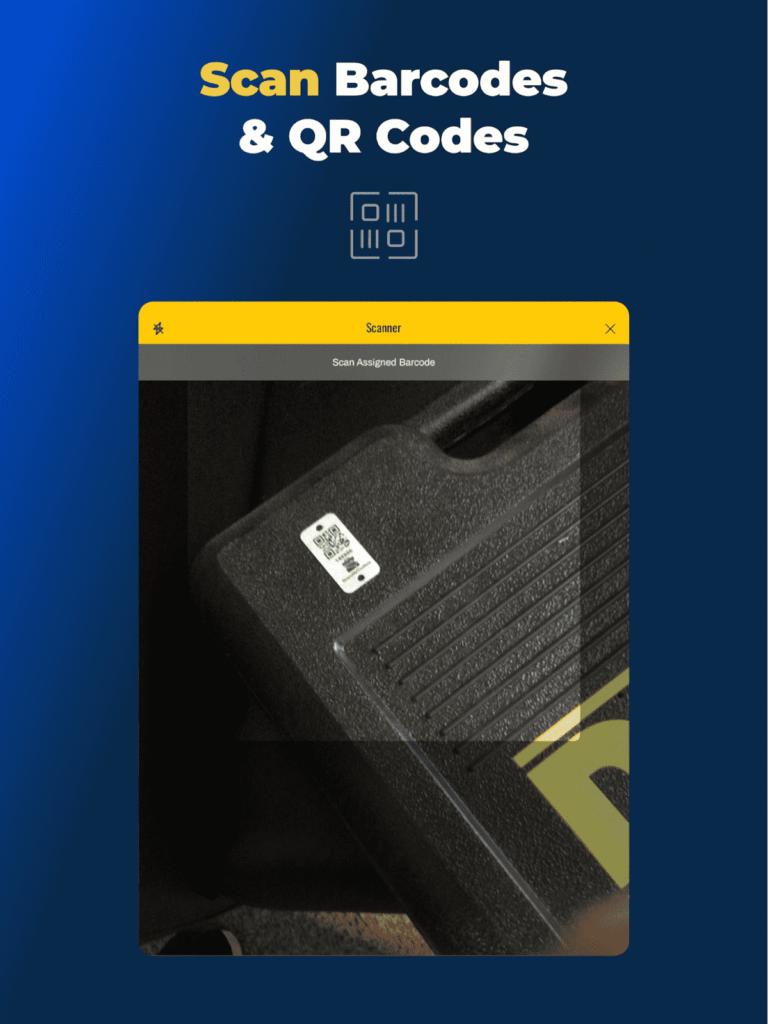
Source: Google Play
You can print your own labels or order standard or custom metal and peel-and-stick asset tags directly through the platform.
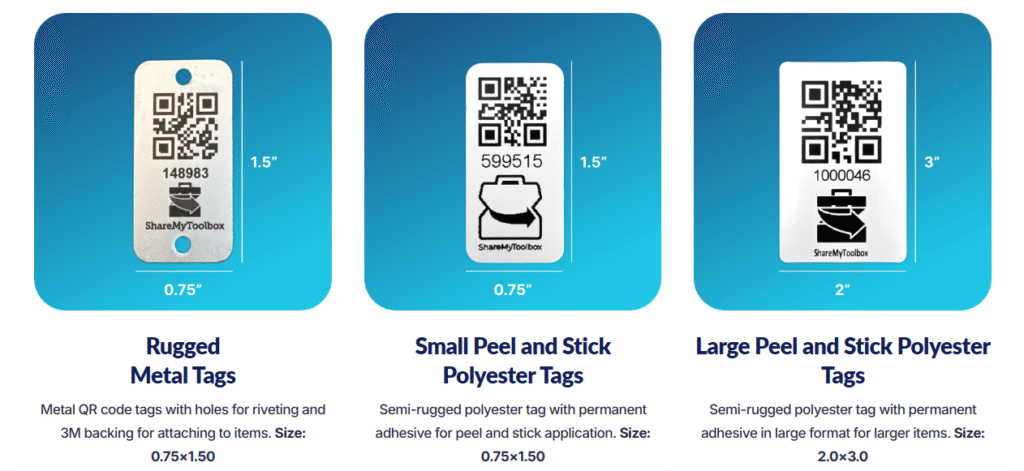
Source: ShareMyToolbox
A bundle of 800 standard-sized polyester and rugged metal tags, their most popular option, can be purchased for $250, sold separately from the monthly subscription fee.
Regardless of how you get your asset tags, once the system is set up, you can make full use of ShareMyToolbox’s asset database.
Although the design seems slightly outdated, you can easily browse tools according to asset category, assigned location, or designated crew or individual.

Source: ShareMyToolbox
You can even color-code different categories for better visibility.
Unlike solutions like GoCodes Asset Tracking and Tenna, ShareMyToolbox doesn’t include GPS functionality.
However, it covers all the core field-first features:
- Tool assignment
- Tool kit creation
- Maintenance scheduling
Thanks to the peer-to-peer tool transfer feature and condition ratings, you can easily track each asset’s movement and useful life, which are important points for construction project managers.

Source: Capterra
However, the same Capterra user also mentioned occasional issues with the loan system not consistently registering check-outs.
ShareMyToolbox comes in two pricing plans.
The Business plan starts at $80/month for the first user, with each additional user (up to five) costing $10 each.
Since costs can scale quickly as your team grows, the company recommends its Enterprise plan for businesses with 100 or more employees or admin users.
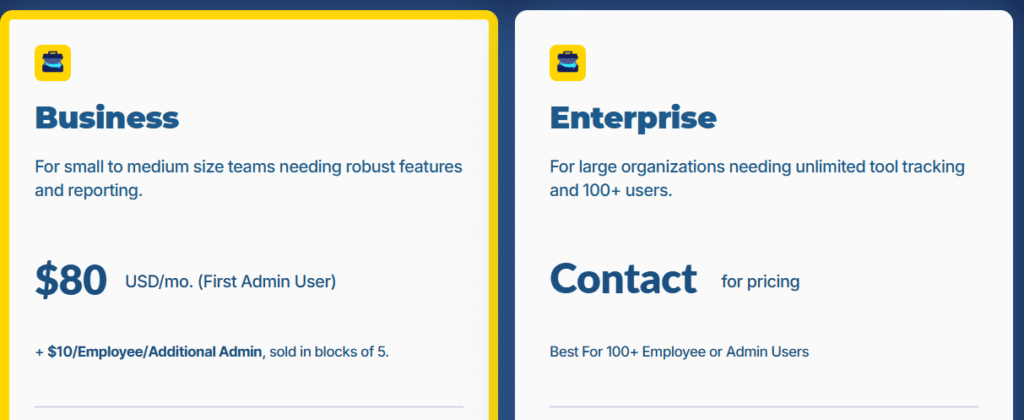
Source: ShareMyToolbox
You can view the full list of included features on the website, but you’ll need to contact their sales team directly for Enterprise pricing details.
Overall, ShareMyToolbox is a solid choice for small to mid-sized contractors seeking a simple, mobile-first tracking solution.
Tenna
Primarily known as a construction fleet management platform, Tenna also offers tool tracking features that you can use to manage smaller, portable equipment.
Its tool tracking capabilities combine QR code labels, Bluetooth (BLE) trackers, and simple image capture to help you document tool conditions and maintenance needs on the go.
Assets can be tagged with durable labels or anodized aluminum tags, then scanned with the Tenna app using a smartphone or tablet to update location and status.

Source: Tenna
These tags have a 10-year lifespan, though customization is limited to just four label options.
This feels restrictive compared to GoCodes Asset Tracking, where users can choose from a wider variety of materials and sizes to better match different tool types and jobsite conditions.

Source: Tenna
Field crews can use image capture within the app to log notes or document servicing needs, while managers benefit from role-based access controls and custom reporting.
Tenna’s tool tracking features are more limited in scope compared to its fleet management tools.
For example, there’s no dedicated check-in/check-out screen, which suggests tool tracking isn’t the main focus.
Instead, the platform emphasizes fleet oversight, with dashboards showing the number of active trackers and overall asset status.
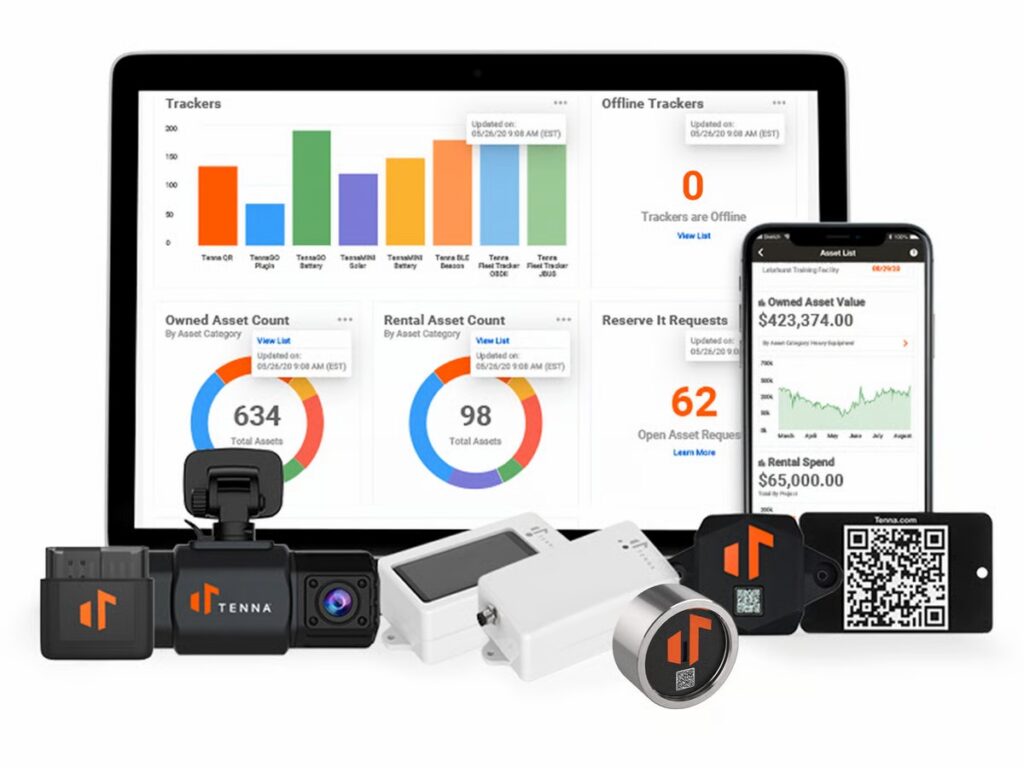
Source: G2
On that same note, Tenna earns high marks for its fleet management tools on review platforms like G2, but faces some criticism for its asset tracking features.
Users note that setup can be time-consuming and requires thorough training to unlock the platform’s full potential.

Source: G2
Tenna’s pricing is customized based on asset count, users, and selected modules, which can be both an advantage and an inconvenience, depending on your needs.

Source: Tenna
That said, Capterra lists the basic plan at $100 per month.
In short, Tenna is a strong fleet management solution with decent tool tracking.
However, for companies prioritizing portable tool oversight, options like GoCodes Asset Tracking offer a more balanced and specialized approach.
Itemit
UK-based itemit is a SaaS asset-tracking platform designed for businesses of all sizes and different industries.
Although not construction-centric, what makes itemit a practical option for small tool tracking is its simple, user-friendly approach, and streamlined use of QR codes for tagging and tracking.
itemit offers a range of asset tags, including vinyl and anodized aluminum varieties, with strong 3M adhesives as a standard.
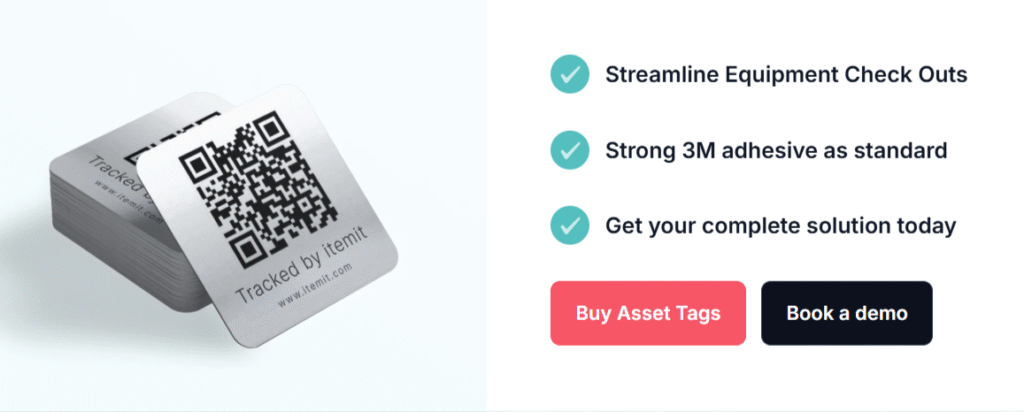
Source: itemit
However, for fully customized labels, you’ll need to reach out directly and check which options can support specific heavy-duty construction environments.
Nevertheless, the system covers a standard set of features that enable streamlined equipment checkouts and bookings, timely reminders and issue reporting, as well as audits.
All this is managed from a central dashboard that gives you a quick overview of filtering options, key action buttons, as well as multiple views.
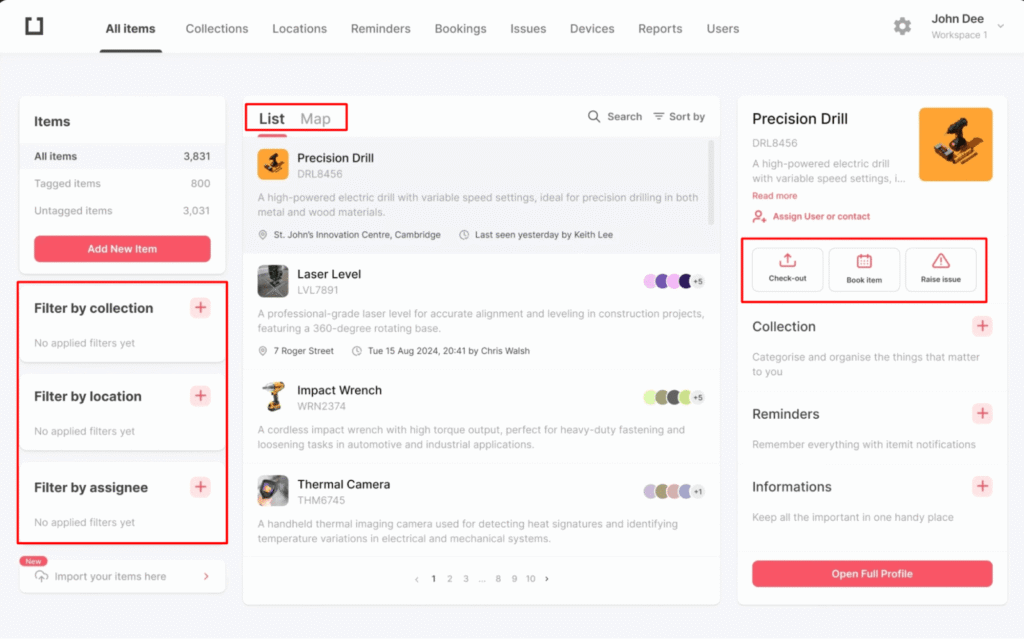
Source: itemit
While it’s easy to navigate, some users have noted that the main item page can feel cluttered, with too much information displayed at once.
Still, features like offline functionality, custom reports, and asset usage summaries make it practical for field teams getting started with digital tracking.
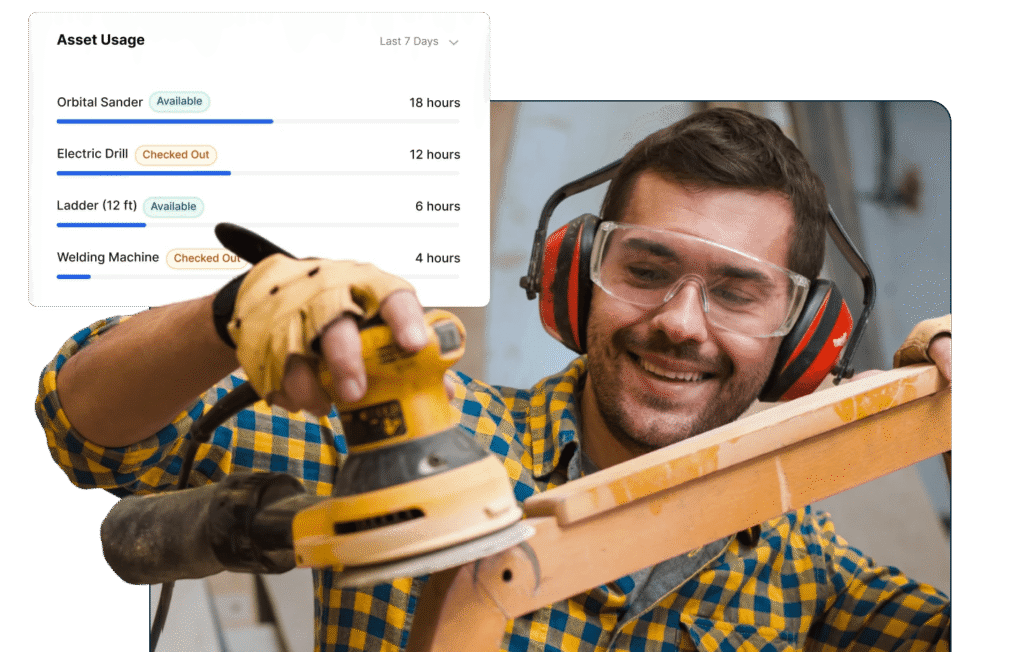
Source: itemit
Software Advice reviewers consistently appreciate itemit’s ease of use and value for money.
However, common downsides include limited search functionalities and fewer customization options, as pointed out by this user.
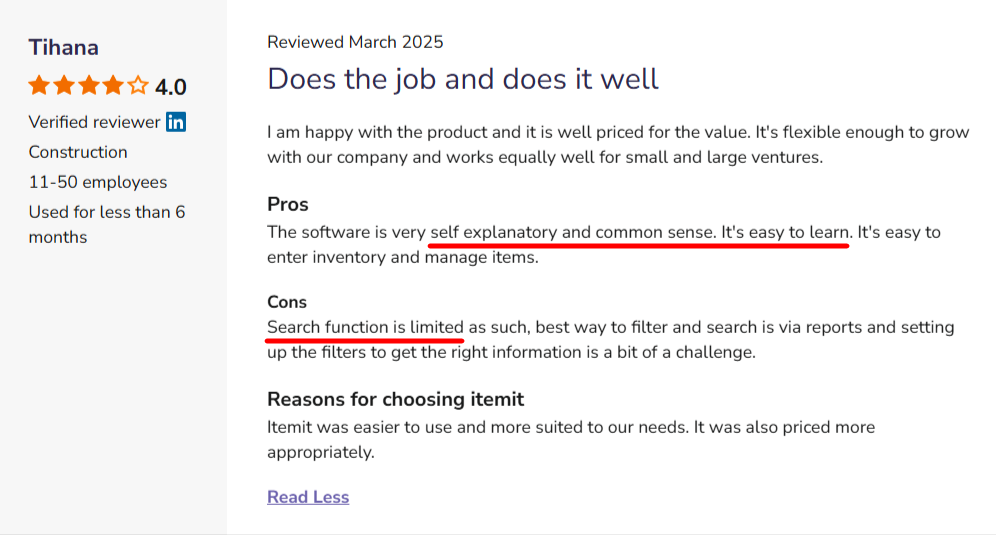
Source: Software Advice
When it comes to pricing, itemit’s Starter plan with up to 1,000 items is priced at $599 a year per user, but for up to three users only.
It’s also worth noting that only Pro and Industrial plans allow an unlimited number of users and GPS tracking capabilities.
Moreover, all asset tags are sold separately.

Source: itemit
All in all, itemit is a strong pick for small to mid-sized construction businesses that need basic tool tracking with offline functionality.
Just keep in mind that those looking to scale or customize extensively may outgrow it over time.
EZO
EZO is another widely used asset tracking and equipment management platform.
While its core product was originally built with IT and office equipment in mind, its QR code-based tracking features make it a capable option for small tool management on construction sites.
The platform covers all the essentials:
- QR code tagging
- Scan-based audits
- Tool check-ins and check-outs
- Real-time status lookups
- Custom reporting
- Location tracking
As showcased in the video, you can also design and print asset labels in bulk right from the software.
Source: EZO on YouTube
Rather than offering a dedicated line of rugged, outdoor-ready labels like GoCodes Asset Tracking and itemit, EZO encourages users to print their own tags, either in-house or through third-party vendors.
This adds flexibility, but it’s less ideal for construction firms that need ultra-durable, weatherproof labels for harsh jobsite conditions.
The dashboard is clean and intuitive, with at-a-glance asset statuses and quick action buttons for both tools and consumables.
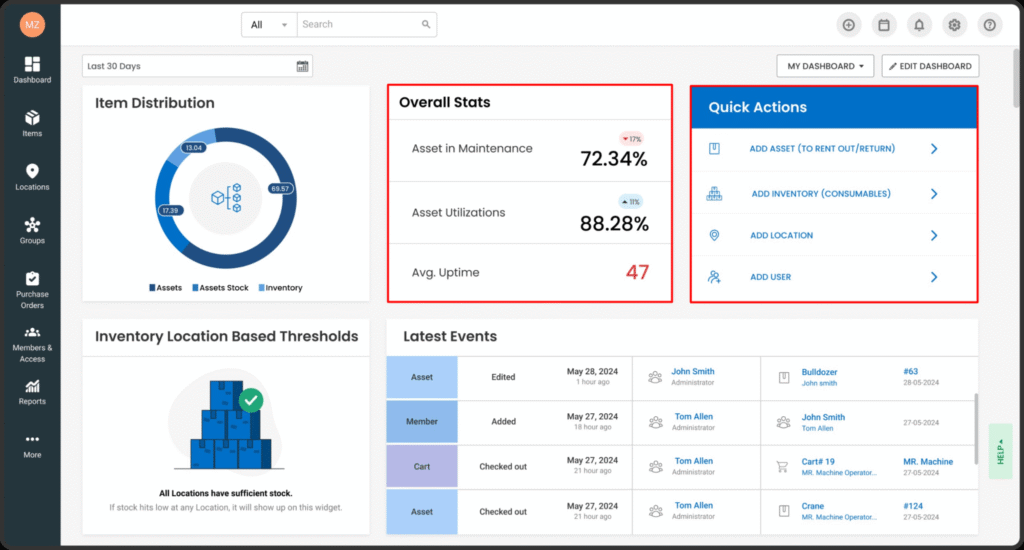
Source: EZO
One of EZO’s standout features is its access control module, allowing managers to set user roles and permissions for specific assets or locations.
Additional capabilities include a reservations module to avoid double bookings and advanced work order workflows to enhance your preventive maintenance efforts.

Source: G2
On review platforms like G2, EZO earns praise for its ease of use and inventory tracking capabilities.
On the flip side, some users point out a steep learning curve and several missing features, like an override action.

Source: G2
When it comes to learning curve and navigation difficulty, some users report that setting up custom reports and service alerts can be unintuitive.
EZO’s pricing is based on how many items you track, not user count.
Plans for tracking up to 250 items are available across three feature levels, starting at $40 per month ($480 per year).
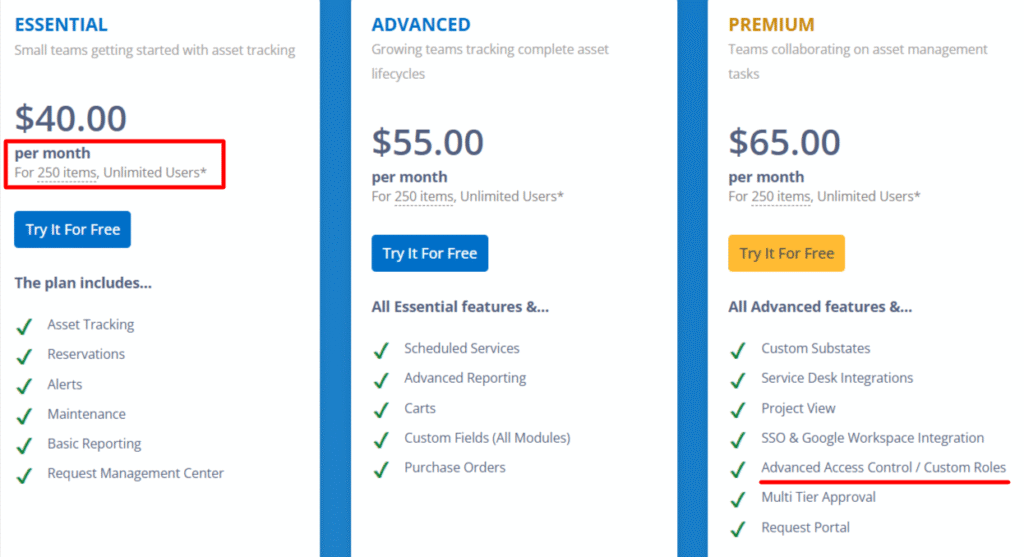
Source: EZO
Unfortunately, the custom role feature that would be most useful for managing subcontractors is only available with the most expensive plan.
Conclusion
QR code tool tracking systems deliver the speed and simplicity your construction crews need.
This roundup highlighted reliable choices for different needs, from plug-and-play tool tracking software to advanced fleet management platforms.
Ultimately, the effectiveness of QR code systems depends on two things: how durable and customizable the labels are, and how well the software supports your day-to-day workflows.
Keep these core factors in mind and choose a solution that aligns with how your crew actually works.
You’ll gain better control of your tools from day one—and be ready to scale as your business grows.




